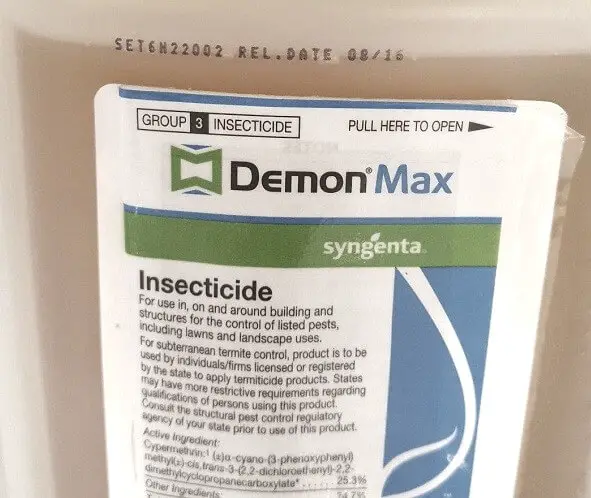Bifenthrin Vs Cypermethrin Insecticide

Bifenthrin and cypermethrin have made a name for themselves as two of the most widely used synthetic pyrethroids in the world of pest control. These chemicals are popular for their effective control of a variety of pests.
Here, we’ll delve deep into the nuances between bifenthrin and cypermethrin, examining their chemical structures, mode of action, target pests, and more.
Bifenthrin Vs Cypermethrin Table
This table of comparison will enable you to quickly distinguish the differences.
| Feature | Bifenthrin | Cypermethrin |
|---|---|---|
| Chemical Structure | C23H22ClF3O2 | C22H19Cl2NO3 |
| Mode of Action | Prolongs sodium channels opening | Rapid “knockdown” effect on sodium channels |
| Target Pests | Ants, termites, fleas, moths, beetles | Aphids, caterpillars, roaches, ticks, spiders |
| Toxicity to Humans | Class C, possible human carcinogen | Skin and eye irritation, mild neurotoxic effects |
| Residual Effect | Lasts several weeks | Lasts a few weeks |
| Usage | Outdoor treatments, turf, ornamental pest control | Household pest control, agriculture |
| Environmental Impact | Highly toxic to aquatic organisms, potential bioaccumulation | Toxic to fish and aquatic invertebrates |
Chemical Structure
At the molecular level, bifenthrin and cypermethrin differ in their chemical structure. Bifenthrin has the chemical formula C₂₃H₂₂ClF₃O₂, whereas cypermethrin’s chemical formula is C₂₂H₁₉Cl₂NO₃.
The presence of different functional groups and atoms in each molecule leads to variations in their respective properties and effectiveness.
Mode of Action
Both bifenthrin and cypermethrin are neurotoxicants that act on the nervous systems of insects. They work by targeting voltage-gated sodium channels in nerve cells. When the insecticides modify these channels, there’s a delay in the closure, leading to an extended period of nerve excitation. This prolonged nerve stimulation results in paralysis and, eventually, the insect’s death.
Target Pests
While both insecticides have a broad spectrum of action, there are subtle differences in their target pests. Bifenthrin is often used against pests like red imported fire ants, aphids, fleas, ticks, and mites.
In contrast, cypermethrin is effective against pests like mosquitoes, cockroaches, and various crop-damaging insects such as moths and beetles.It’s worth noting that both insecticides can be used against many of the same pests; however, effectiveness can vary based on concentrations and specific formulations.

Toxicity to Humans
Like all pyrethroids, bifenthrin, and cypermethrin exhibit low acute toxicity to humans when used as directed. However, overexposure or misuse can lead to symptoms like dizziness, nausea, and tingling sensations. Of the two, bifenthrin generally has a slightly higher margin of safety for humans, with cypermethrin presenting a marginally higher risk of skin irritation.
Residual Effect
Bifenthrin boasts a longer residual effect when compared to cypermethrin. In optimal conditions, bifenthrin can remain effective for several weeks after application. On the other hand, cypermethrin typically has a shorter residual duration, often requiring more frequent reapplications for consistent pest control.
Usage
Both insecticides find use in a wide range of applications. Bifenthrin is favored for termite treatments, turf pest control, and agricultural applications, especially in cotton crops. Cypermethrin is often used in household pest control products, mosquito nets, and agriculture, especially for food crops like vegetables and cereals.

Environmental Impact
As a class, pyrethroids are known to be toxic to aquatic life, and this extends to both bifenthrin and cypermethrin. However, bifenthrin tends to be more persistent in aquatic environments and may pose a higher risk to fish and other water organisms.
Cypermethrin, while also toxic to aquatic life, degrades more quickly. If not used judiciously, both insecticides can impact beneficial insects, with honeybees being particularly susceptible.
Conclusion
Both bifenthrin and cypermethrin have their unique advantages. Bifenthrin’s prolonged residual effect makes it ideal for barrier treatments, while cypermethrin’s quick action is preferred for immediate pest knockdown.
However, the environmental impacts, especially on aquatic life, can’t be ignored. Safe and responsible usage, keeping in mind the specific needs and situations, is recommended.
To sum up, while bifenthrin and cypermethrin are potent tools against pests, they have drawbacks. Proper handling and mindful application are essential for achieving the desired results without causing undue harm to the environment or ourselves.

James E. Butkovich, Pest control maven with a knack for eco-friendly & Chemical solutions. Blogger with a mission to make homes pest-free, one post at a time.